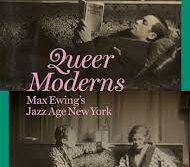 Cecil Dreeme: A Novel
Cecil Dreeme: A Novel
by Theodore Winthrop
NYU Press. 288 pages, $16.95
AND NOW FOR SOMETHING completely different! When the publishers of this 1861 book describe it as “one of the queerest novels of the 19th century,” they’re not exaggerating. Cecil Dreeme is remarkable, compelling, and utterly unclassifiable.
The long-forgotten Theodore Winthrop (1828-1861) was a lawyer, traveler, novelist and critic who had once inhabited the NYU premises on Washington Square in which Cecil Dreeme is set. He wrote the novel secretly, knowing that its deeply sensual, implicitly sexual content made it unpublishable in its lifetime. I have found no evidence that Oscar Wilde discovered the book—though it may have been pressed into his hands at some point during his extensive lecture tour of the U.S. in 1882 and ’83.
Cecil Dreeme concerns the circumstances of one Robert Byng, an obvious self-portrait of Winthrop himself, as he returns to Manhattan following extensive travels. Byng is unmarried, unemployed, and seemingly friendless. He anticipates in so many ways the rootless figure of the flâneur that would feature so prominently in the Decadent literature of the European fin de siècle. Byng takes rooms in Washington Square’s “Chrysalis College,” a fictional stand-in for NYU, and soon finds himself besotted with a young, elusive painter, Cecil Dreeme, whose very name suggests that he’s a figment of the author’s fantasy. Byng confides to the reader that he has, to his own confusion, come to “love Cecil with a love passing the love of women,” one of many allusions to biblical scripture (referring to David’s love for Jonathan).
Enter the hubristic figure of Densdeth, a compelling Machiavellian anti-hero very much the equal of Balzac’s criminal and sexually ambiguous Vautrin in La Comédie Humaine, which was undoubtedly an important source for Winthrop. Byng is introduced by a mutual friend to the doomed young man Towner, whose social ruin can be laid directly at the feet of Densdeth’s influence. This closely foreshadows the effect of Wilde’s Lord Henry Wootton on the artist Basil Hallward in The Picture of Dorian Gray. Towner himself attributes his own ruin to the sinister power wielded by Densdeth in startlingly sensual and melodramatic terms: “The first time he saw me, he laid his finger on the bad spot in my nature, and it itched to spread. I have been his slave, soul and body, from that moment.”
Despite this illustration of the dangers of Densdeth’s depraved influence, Byng cannot easily resist it. As Peter Corviello notes in a lucid and insightful introduction, Winthrop must have been fully aware that in Cecil Dreeme he was writing a book replete with moral ambivalence, just as Wilde’s later story was. The resulting tale, Corviello notes, “inhabits the familiar narrative postures of moralizing horror, [yet]is also a novel committed, with remarkable tenacity, to its perversities.” Corviello invokes critic Eve Kosofsky Sedgwick’s ideas (in 1985’s Between Men in particular) by identifying in Byng the “sexual panic” that is found in many mid- to late-19th-century Gothic novels. This panic, according to Sedgwick, stems from the fear that the homosocial attraction between two young men belies a fundamentally erotic attraction. Where Gothic fictions had previously deployed either geographic remoteness or psychological seclusion to induce terror in their protagonists and readers, Cecil Dreeme found its terror in the thronging West Village, homing in on a close-knit, overwhelmingly male, fundamentally insecure subculture. It thus anticipated the 1890s and the largely European body of fiction that has come to be known as Urban Gothic.
Winthrop’s novel bears some comparison with the nearly contemporary stories of Herman Melville, Nathaniel Hawthorne, and Edgar Allen Poe, as well as with the concepts of male kinship and sexual “adhesiveness” slowly being investigated by Walt Whitman in Leaves of Grass. But it is a tribute to his own creative idiosyncrasy and wider learning that Winthrop’s novel remains distinct from any sense of an emerging homoerotic tenor in American Renaissance writing. Cecil Dreeme is sui generis. Byng’s fear of his own social indeterminacy, even invisibility, may well have had its seed in Winthrop’s own self-account to his family and peers. It further articulates the sense of a secret sin and the consequent shame that’s central to The Scarlet Letter and Hawthorne’s other works.
Yet again, Cecil Dreeme takes this further. Take Byng’s own account of what marriage symbolizes, and how it works upon man and wife: “Antagonistic natures do not necessarily make man and woman hostile, even when they are imprisoned for life in matrimony; domestic life stirs and stirs, slow and steady, and at last the two mix, like the oil and mustard in a mayonnaise.” It is a platitude to point out that wedlock is rarely an ideal state. But Byng offers a more extreme view, using a metaphor that suggests a python-like suffocation for all who succumb to it.
The resolution of Densdeth’s pursuit of Byng, and in turn of Byng’s pursuit of Cecil Dreeme, cannot be disclosed without spoiling the book for the uninitiated. Suffice it to say that the young Dreeme’s androgynous appearance, and indeed his unmanly social position as a reclusive artist, hark back to Romantic archetypes, while his name intentionally instills in the reader a sense of something intimate between young men that cannot be defined, only imagined. However, it might—in a place and time not open yet to Byng or to Winthrop—have a persistence and legitimacy such that one day it will be fully realized.
This is a remarkable, prophetic, and rich novel whose very existence must be seen as surprising against the backdrop of 21st-century skepticism as to the possibility of “gay” literature in pre-modern times. It deserves the widest possible readership.
Richard Canning’s most recent book is an edition of English novelist Ronald Firbank’s Vainglory (Penguin Classics, 2012).




